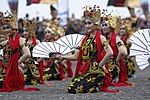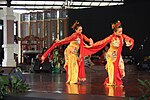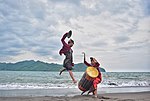Sisingaan
 Sisingaan dance performance in Taman Mini Indonesia Indah, Jakarta | |
| Genre | Lion dance |
|---|---|
| Origin | Indonesia |
| Sisingaan |
|---|
|
| Burma |
| Cambodia |
|
| Indonesia |
|
| Laos |
|
| Malaysia |
| Philippines |
| Thailand |
| Vietnam |
Sisingaan or also known as Gotong Singa, Singa Ungkleuk, Singa Depok, Kuda Ungkleuk, Pergosi or Odong-odong, is a traditional Sundanese lion dance originated from Subang, West Java, Indonesia.[1] This lion dance performance marked by a form of an ark or palanquin that resembles a lion. The lion ark or lion-shaped effigy is carried by a group of dancers who perform various attractions accompanied by traditional music.[2] The lion palanquin is being ride by a children. This dance usually performed to celebrate the child's circumcision ceremony, where the child is carried on a lion around the kampung (village).[3]
Etymology[]
In Sundanese language the term sisingaan means "imitation lion", "playing the lion" or "lion play". This refers to the form of a lion-like effigy that is the main part of the show.[4]
Form[]
Unlike other lion dances however, this lion dance is quite different. It uses lion-like statue or an effigy doll that resembles a lion in couchant (lying down) position, being held in a palanquin-like structure by four or two men with bamboo rods. This lion statue is being ride by a children, as the lion being carried away and held high by these men in certain dance movements, sometimes involved acrobatics. The dance is accompanied with a traditional music troupe consists of musicians playing musical instruments; including kendang (drum), kempul, gong, suling bamboo flute and trumpet.[1]
History[]

The early art of Sisingaan dance was took form in early 19th century, as a form of native's mockery and contempt to European colonialism. At that time Subang Regency was called Pamanoekan en Tjiasemlanden which means a region between Pamanukan and Ciasem in West Java. Between 1811–1816, Java was ruled by the British during a short period of British Java. At that time, the British invested heavily in sugar plantation in Java, especially in Subang region, thus ruled the economic aspect of the region. However, this economic exploitation through forced plantation has led to the cultivation system (cultuurstelsel) that harm local farmers.[5]
The natives found out that lion emblems symbolize European colonialism of both British and Dutch. As a form of resistance through symbolism in art, the native Sundanese farmers create a dance which involved a lion effigy being ride by a children. Four men that carrying the lion palanquin representing local farmers that being exploited by European colonials. However, the lion in return being ride by a children, which insinuated that in the future, the younger generation will rules. Which means the East Indies will eventually become independent or being liberated by the future generation.[1]
Gallery[]

Sisingaan dance performance in a village.
Sisingaan dance with kids riding the lion effigy.

Sisingaan lion dance parade during Independence day parade in 2008 Merdeka Square, Jakarta.
See also[]
References[]
- ^ Jump up to: a b c "Sisingaan, Sindiran Ala Orang Sunda". Indonesia.go.id (in Indonesian). 23 December 2019.
- ^ Dipa, Arya (3 June 2014). "Preserving hamlets via art in Sekejolang". The Jakarta Post. Retrieved 2021-02-25.
- ^ "Sisingaan". kompas.id. Retrieved 2021-02-25.
- ^ Riky. ""Singa Jinak" Khas Masyarakat Subang". Indonesia Kaya (in Indonesian).
- ^ ditwdb (2019-07-29). "Sejarah Sisingaan, Kesenian Asal Jawa Barat". Direktorat Warisan dan Diplomasi Budaya (in Indonesian). Retrieved 2021-02-25.
External links[]
| Wikimedia Commons has media related to Sisingaan. |
- Dances of Java
- Sundanese culture









